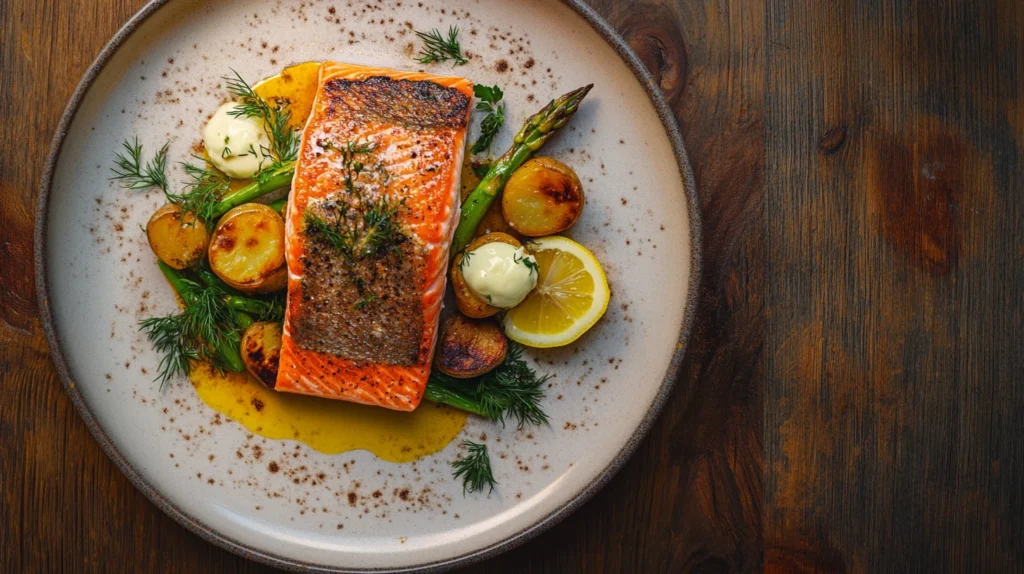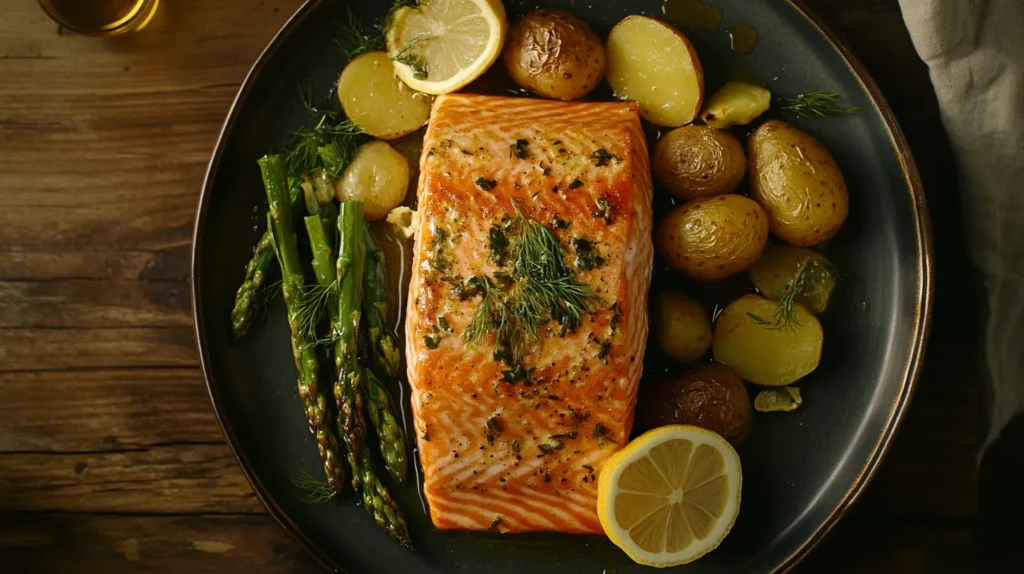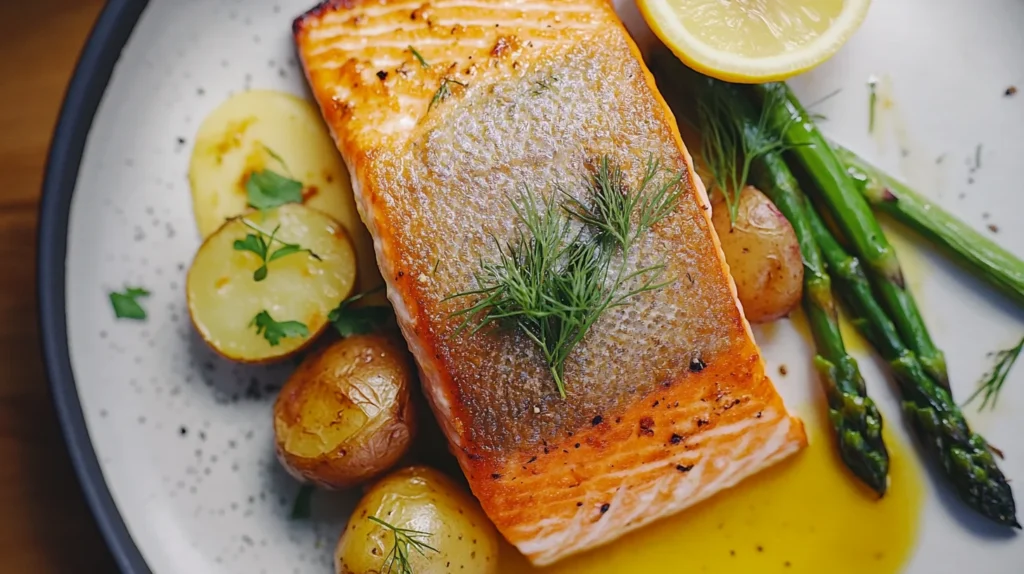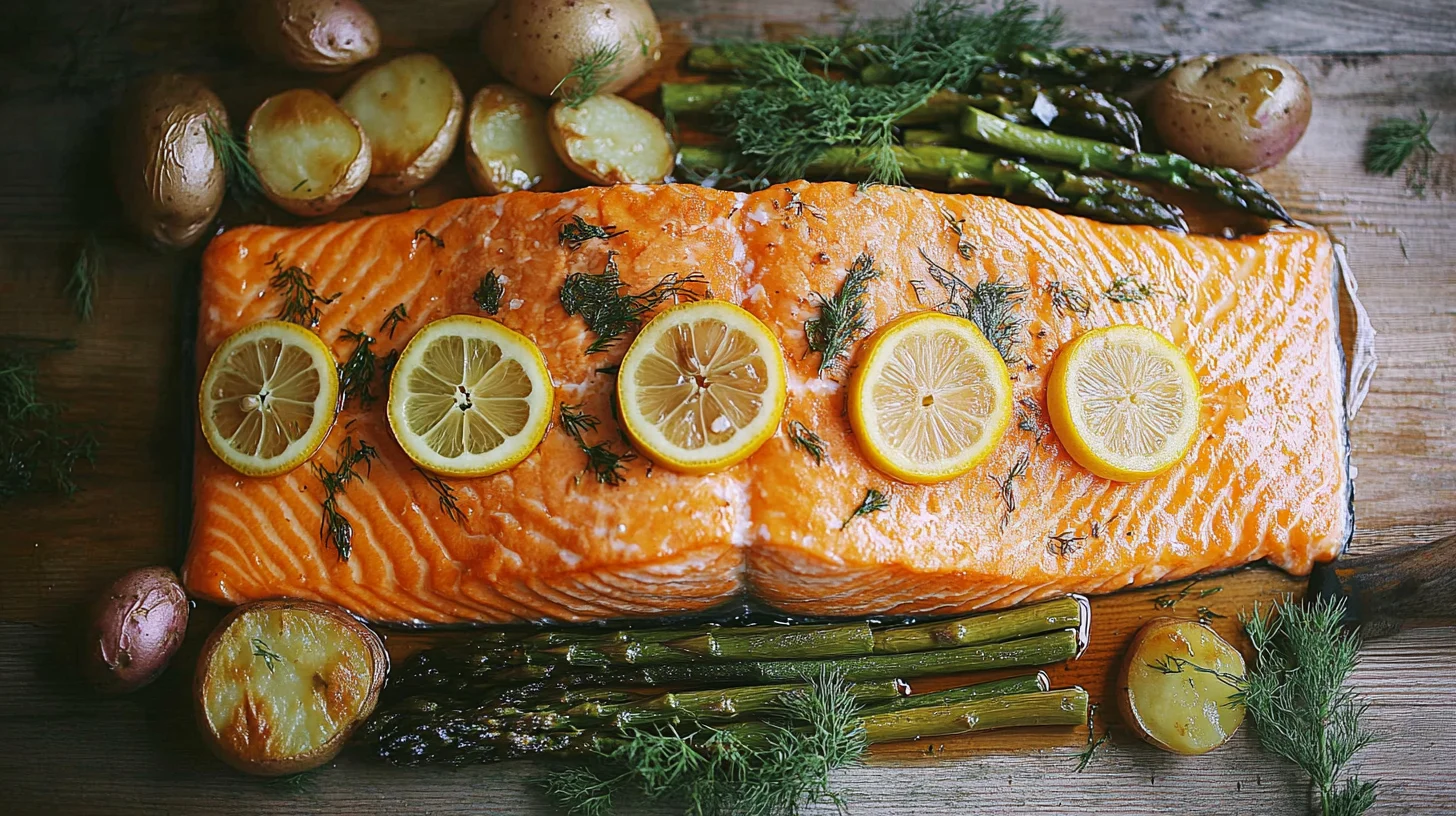What is the Most Flavorful Way to Cook Salmon? Discover a Delicious Recipe
What is the most flavorful way to cook salmon? This question resonates with both culinary enthusiasts and home cooks alike, as salmon stands out for its rich taste and versatility. Whether grilled, baked, or smoked, there are countless ways to prepare this delectable fish, each method imparting its unique flavor profile. In this article, we will explore various cooking techniques, flavor pairings, and regional styles that elevate salmon dishes into extraordinary culinary experiences.
Check out the full article for the complete recipe and all the details on this easy, flavorful, and healthy Maple Dijon Salmon!

The Most Flavorful Ways to Cook Salmon to Perfection
Salmon is more than just a popular ingredient; it’s a culinary treasure that offers an array of flavors, textures, and health benefits. Understanding how to maximize its potential can transform your meals from simple to spectacular. Let’s dive into the nutritional benefits, varieties, and importance of freshness in salmon preparation.
Nutritional Benefits of Salmon
Salmon is widely regarded as a superfood due to its exceptional nutritional profile. It is an excellent source of high-quality protein, omega-3 fatty acids, and essential vitamins and minerals, making it a perfect choice for a healthy diet.
Omega-3 fatty acids found in salmon are known for their anti-inflammatory properties and heart health benefits. Regular consumption of these healthy fats can lower blood pressure, reduce triglyceride levels, and decrease the risk of heart disease. Alongside omega-3s, salmon is also packed with vitamin D, B vitamins, selenium, and potassium, contributing to overall wellness.
Beyond its nutritional value, salmon’s rich flavor makes it a favorite among seafood lovers. Its natural oils create a buttery mouthfeel, enhancing the taste while ensuring that the fish remains moist even after cooking. With such a remarkable profile, it’s no wonder that many chefs and home cooks seek to discover the most flavorful ways to cook salmon.
Varieties of Salmon and Their Flavor Profiles
Not all salmon is created equal. Various species offer unique flavor profiles and textures that can dramatically influence your cooking approach. Here are some of the most popular types of salmon:
Chinook salmon, often referred to as king salmon, is known for its high-fat content and buttery flavor. It has a rich, silky texture that melts in your mouth, making it a gourmet choice for special occasions.
Sockeye salmon, with its vibrant red flesh, boasts a robust, slightly sweet flavor and firm texture. It’s perfect for grilling or roasting, as its meat holds up well against high heat.
Coho salmon strikes a balance between the richness of Chinook and the boldness of Sockeye. Its moderate fat content and mild flavor make it an excellent candidate for various cooking methods, particularly poaching and baking.
Pink salmon, the most abundant variety, has a lighter flavor and softer texture. While not as rich as its counterparts, it takes well to strong marinades and seasonings, making it a versatile option for everyday meals.
Each salmon variety brings its unique characteristics to the table, allowing cooks to select the one that best suits their recipe and desired outcome.
The Importance of Freshness in Flavor
When it comes to salmon, freshness is key. The flavor and texture of salmon deteriorate over time, which can lead to an unpleasant eating experience. Whether you’re purchasing salmon from a fish market or your local grocery store, always take note of its freshness.
Fresh salmon should have a bright, vibrant color without any dullness or discoloration. The flesh should be firm to the touch and bounce back when pressed. Additionally, the aroma should be clean and oceanic—not fishy. If you’re unsure about the freshness, don’t hesitate to ask questions or seek recommendations from the vendor.
Using fresh salmon not only enhances the flavor but also provides a better overall cooking experience. When cooked properly, fresh salmon will remain moist and flavorful, allowing the natural qualities of the fish to shine. Investing in quality ingredients is essential for achieving the most favorable results in your culinary endeavors.
Cooking Techniques to Enhance Flavor When You Cook Salmon
Having explored the foundations of salmon, let’s delve into the cooking techniques that can truly enhance its rich flavors. Each method has its distinct advantages, allowing you to achieve varying results based on your preferences.
Grilling: The Best Way to Cook Salmon with Smoky Richness
Grilling salmon is one of the most popular methods, as it imparts a delicious smoky flavor that complements the fish’s natural richness. The high heat of the grill creates those coveted charred marks while locking in moisture.
When preparing salmon for grilling, consider marinating it beforehand. A simple marinade made from olive oil, lemon juice, garlic, and your choice of herbs can infuse the fish with additional depth. Allow the salmon to soak in the marinade for at least 30 minutes, giving the flavors time to penetrate.
To achieve perfectly grilled salmon, preheat the grill and ensure it’s well-oiled to prevent sticking. Place the salmon skin-side down for optimal cooking and flip it only once. The result is a beautifully caramelized exterior with a tender, juicy interior—an experience that elevates the dish to a whole new level.
As you serve grilled salmon, consider pairing it with sides like grilled vegetables or a refreshing salad to create a balanced meal that highlights the fish’s smoky undertones.
Baking: Infusing Aromatic Herbs and Spices
Baking salmon is another fantastic way to enhance its flavor while ensuring a moist, tender result. This method allows for plenty of creativity, as you can easily incorporate aromatic herbs and spices to compliment the fish.
One effective technique for baking salmon is to create a bed of thinly sliced vegetables, such as zucchini, bell peppers, and onions. Place the salmon on top, drizzle it with olive oil, and sprinkle it with your favorite herbs—dill and thyme work particularly well. The steam generated during baking helps to infuse the salmon with both moisture and flavor.
For added depth, consider topping the salmon with a mixture of breadcrumbs, grated cheese, and garlic before placing it in the oven. This adds a crunchy texture that contrasts beautifully with the soft, flaky fish.
Baked salmon pairs wonderfully with grains like quinoa or couscous, providing a wholesome, satisfying meal that celebrates the flavors of the fish.
Searing: Achieving a Perfectly Crispy Skin
Searing salmon is a technique that produces a stunning contrast of textures, with a crispy, golden-brown skin and a tender, flaky interior. This method requires a hot pan and a bit of patience to achieve the ideal result.
To start, pat the salmon dry with paper towels to ensure that the skin crisps up nicely. Season the fish generously with salt and pepper. Heat a nonstick skillet over medium-high heat and add a splash of oil. Once the oil shimmers, carefully place the salmon skin-side down in the pan.
Allow the salmon to cook undisturbed for several minutes until the skin becomes crisp. Resist the temptation to flip it too early, as this could lead to tearing. After a few minutes, gently turn the fish over to finish cooking.
Searing salmon yields a beautiful presentation, showcasing the crispy skin while retaining the moistness of the flesh underneath. Serve with a squeeze of lemon and a side of roasted potatoes for a delightful meal that showcases this cooking technique.
Poaching: A Gentle Method for Retained Moisture
Poaching may not be the first cooking method that comes to mind when thinking about salmon, but it is worth exploring due to its ability to preserve moisture while imparting delicate flavors. This gentle cooking technique involves simmering the fish in liquid, such as broth, wine, or citrus-infused water.
To poach salmon, start by creating a flavorful poaching liquid. Combine water or broth with aromatics like bay leaves, lemon slices, and fresh herbs. Bring the mixture to a gentle simmer, then introduce the salmon fillets. Cover the pot and allow the fish to cook slowly, resulting in a tender, melt-in-your-mouth texture.
The beauty of poaching lies in its versatility. You can experiment with different liquids and flavor combinations, tailoring the dish to your taste. Serve poached salmon with a light vinaigrette or a creamy sauce for an elegant presentation.
Smoking: Deepening Flavor Through Technique
Smoking salmon is a time-honored tradition that adds complexity and depth to the flavor profile. This technique involves exposing the fish to smoke from wood chips, resulting in a unique taste that cannot be replicated through other cooking methods.
There are two primary methods for smoking salmon: cold smoking and hot smoking. Cold smoking preserves the fish’s raw texture while infusing it with flavor, making it ideal for dishes like gravlax. Hot smoking, on the other hand, cooks the salmon while simultaneously imparting smokiness.
Regardless of the method chosen, seasoning the salmon before smoking is crucial. A dry rub made from brown sugar, salt, and spices can create a beautifully caramelized crust that enhances the overall experience.
Smoked salmon can be enjoyed in various ways—from classic bagels with cream cheese to upscale appetizers served on crackers. The possibilities are endless, making smoking an exciting avenue for flavor exploration.

Flavor Pairings That Elevate How to Cook Salmon to Perfection
Now that we’ve covered various cooking techniques, let’s explore the flavor pairings that can elevate your salmon dishes. By combining the right herbs, spices, marinades, and accompaniments, you can create truly memorable meals.
Herbs and Spices: The Best Combinations
Herbs and spices play a vital role in enhancing the natural flavors of salmon. They can brighten the dish while adding layers of complexity. Some of the best herb and spice combinations include:
Dill and lemon: A classic pairing that highlights salmon’s natural flavors, dill brings a fresh, herbal note while lemon adds brightness.
Garlic and parsley: This combination infuses the fish with aromatic depth. Garlic’s robust flavor perfectly complements the earthiness of parsley, resulting in a well-rounded dish.
Cumin and coriander: For a bolder approach, try using warm spices like cumin and coriander. These spices provide a distinctive touch that pairs surprisingly well with salmon.
Experimenting with different combinations allows you to tailor the flavor profile to suit your preferences and the specific dish you’re preparing.
Marinades and Rubs: Crafting Your Ideal Blend
Marinades and rubs are fantastic tools for enhancing salmon’s flavor before cooking. A well-crafted marinade can penetrate the fish, infusing it with complementary tastes. Consider the following ideas for marinades and rubs:
Soy sauce and ginger: A simple mixture of soy sauce, ginger, and garlic creates a savory marinade that works wonders for grilled or baked salmon.
Maple syrup and mustard: Combining maple syrup with Dijon mustard results in a sweet and tangy glaze that caramelizes beautifully during cooking.
Spicy harissa paste: For those who enjoy heat, a rub made from harissa paste, olive oil, and lime juice can elevate salmon to new heights of flavor.
When marinating, aim to let the salmon soak for at least 30 minutes to allow the flavors to meld. Rubs can be applied just before cooking for a quick flavor boost.
Accompaniments: Side Dishes That Complement Salmon
Pairing salmon with the right side dishes can enhance the overall dining experience. Consider sides that provide balance and contrast to the rich flavors of the fish. Here are some ideas:
Quinoa salad: A light quinoa salad with fresh vegetables, herbs, and a zesty dressing pairs beautifully with salmon, offering a nutritious and vibrant side.
Roasted asparagus: Earthy roasted asparagus drizzled with lemon juice provides a delightful complement to salmon’s richness.
Creamy mashed potatoes: For a comforting touch, serve salmon alongside creamy mashed potatoes enriched with butter and garlic.
By thoughtfully considering accompaniments, you can create a harmonious meal that celebrates the flavors of salmon.
Exploring Regional Styles: How to Cook Salmon from Around the World
Around the world, various cultures have developed unique styles of cooking salmon that reflect their culinary traditions. Exploring these regional approaches can inspire new techniques and flavor profiles.
Nordic Cuisine: Cured and Preserved Methods
Nordic cuisine emphasizes simple yet flavorful preparations that often involve curing or preserving fish. Techniques like gravlax—a Scandinavian delicacy—involve curing salmon with a mixture of salt, sugar, and dill. The process draws out moisture, resulting in tender, flavorful fish that can be served as an appetizer or on open-faced sandwiches.
Another traditional method is smoking, which is prevalent in countries like Norway and Sweden. Both cold and hot smoking techniques are used to produce rich, flavorful salmon that pairs well with rye bread, pickled vegetables, and mustard sauce.
Incorporating these Nordic methods into your salmon repertoire can broaden your culinary horizons and introduce new flavors to your palate.
Japanese Influence: Teriyaki and Sushi Techniques
Japanese cuisine has significantly influenced the way salmon is prepared and enjoyed worldwide. Salmon teriyaki is a popular dish that features marinated fish glazed with a sweet soy sauce mixture and grilled to perfection. The result is a deliciously sticky, flavorful dish that highlights the fish’s natural sweetness.
Sushi and sashimi preparations also showcase salmon in a different light. Fresh, high-quality salmon is sliced thinly and served raw, allowing diners to appreciate its delicate texture and flavor. Pairing sushi with wasabi, soy sauce, and pickled ginger creates a beautiful balance of tastes and sensations.
Exploring Japanese techniques can inspire innovative ways to enjoy salmon while honoring its natural qualities.
Pacific Northwest: Traditional Indigenous Approaches
The Pacific Northwest region of the United States and Canada has a rich history of salmon consumption among Indigenous peoples. Traditional methods revolve around sustainability and respect for the fishery, focusing on seasonal catches and preserving the integrity of the salmon.
Indigenous cooking techniques often involve roasting salmon over an open fire or using cedar planks to infuse the fish with a subtle woodsy flavor. Techniques like drying or smoking are also commonly employed to preserve salmon for future use.
Embracing these indigenous methods pays homage to the cultural significance of salmon in the region and encourages an appreciation for local ingredients and sustainable practices.

Common Mistakes to Avoid When You Cook Salmon
While cooking salmon can be straightforward, there are common pitfalls that can detract from the final result. Here are some mistakes to avoid for optimal outcomes.
Overcooking: Ensuring Perfect Doneness
Overcooked salmon is dry and unappealing, robbing the dish of its natural richness. To achieve perfect doneness, monitor the cooking process closely and rely on visual cues rather than strict cooking times.
A general rule of thumb is to remove the salmon from heat when it reaches an internal temperature of around 125°F to 130°F (medium rare) or 145°F (well done). The residual heat will continue to cook the fish as it rests.
Utilizing a meat thermometer can help eliminate guesswork and ensures that your salmon retains its moisture and flavor.
Underseasoning: Enhancing, Not Overpowering Flavors
While salmon has a naturally rich flavor, underseasoning can leave the dish bland. Avoid skimping on salt, herbs, and spices. Experiment with seasonings to find the right balance that enhances the fish without overpowering it.
Remember that the right amount of seasoning should uplift the flavor without masking the essence of the salmon. Taste as you go, adjusting seasonings to create the perfect balance.
Ignoring Skin: Utilizing All Parts of the Fish
Many home cooks disregard the skin when preparing salmon, but it can add an additional layer of flavor and texture to the dish. When cooked correctly, salmon skin becomes crispy and delicious, enhancing the overall experience.
If you’re not a fan of eating the skin, consider keeping it on during the cooking process to retain moisture and flavor. You can always remove it before serving if desired. Embracing all parts of the fish maximizes the culinary potential of salmon.
Conclusion about how to cook salmon?
Discovering what is the most flavorful way to cook salmon leads us through a journey of techniques, flavor pairings, and regional influences. From grilling and baking to poaching and smoking, each method brings out the unique qualities of this versatile fish. Incorporating aromatic herbs, creative marinades, and thoughtful accompaniments results in memorable meals that celebrate salmon’s rich flavors.
With a deeper understanding of salmon’s nutritional benefits, varieties, and cooking methods, you can confidently explore the complexities of this culinary gem. Embrace the art of cooking salmon, and allow your creativity to shine as you craft dishes that showcase the beauty and flavor of this beloved fish.


1 Comment-
Pingback: Discover Healthy Eating with Barilla Protein Pasta - A Delicious Upgrade